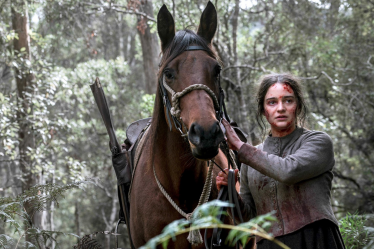

If God is silent in the presence of human suffering, is he a god worth praising? Martin Scorsese’s SILENCE, a brutal film that leaves the viewer with that question and many others about faith, sacrifice, and what constitutes godliness, is being released nationwide this weekend. This has been the director’s passion project most of his career, simmering until he began working to get it made in the early 1990s, shortly after the release of THE LAST TEMPTATION OF CHRIST in 1988, which coincidentally is one of my least favorite of his films. It too demanded we ask ourselves questions about how we live in, or how we choose to reject faith. THE LAST TEMPTATION OF CHRIST approaches religious inquiry through an alternate portrayal of the life of Jesus, while SILENCE asks its questions through the experience of men of the cloth, and the religious converts they have brought into the fold. After all this time and work, does SILENCE deserve an honored place in the history of films examining faith?
Portuguese Jesuit priests Rodrigues (Andrew Garfield) and Garupe (Adam Driver) are trained missionaries who request from their superior Father Valignano (Ciaran Hinds) they be allowed to search for their mentor Ferreira (Liam Neeson). He is believed to be one of many Christians who have been tortured and murdered by the government of Japan, which has outlawed Catholicism, the practice of the religion, and the presence of any Catholic priests in the country. Though warned of the danger, Rodrigues and Garupe embark on a mission to Japan to find Ferreira. Once there, they struggle with the violence, torture, and fear that permeates areas of the country where converts are forced to worship in secret. Those who have chosen to embrace Christianity are often rounded up and made to stomp on a Christian relic in denunciation of their religion. If they do not, they are slowly killed in ways that include being burnt alive, slowly drowned while tied to a cross in the rising tide, being beheaded. These executions are meant to disestablish any commitment to Christianity. All the while, Rodrigues, acting as narrator, prays to hear the voice of God for an affirmation of faith. It is in the silence of his prayers that belief, faith, what God, the shepherd, asks of his flock, and his understanding of what it means to be Christlike, is tested.
SILENCE is based on an award-winning1966 novel by Japanese author Shusaku Endo. Endo examines what it means for priests, for those who carry the message of faith, to be devoted to not only the love of God, but equally to those they lead in spirit. As messengers and leaders, what is their responsibility to the converts who are being tortured and killed for their new beliefs? Being both human and men of God, should they maintain the same silence as their god? Is that the best expression of God’s love, or should they do all they can do end suffering on Earth?
This movie isn’t for everyone. Some will have little interest in the story on which SILENCE is based. It will be a real challenge to those not ever pondering spirit and religion, and its place in society in building a framework for morality. As a former Catholic who attended Catholic boarding school, I understand the structure of the church, and the importance of conversion in their teachings. Obviously SILENCE is done from the perspective of Catholicism, which means without consideration of the morality and acceptability of cultural invasion inherent in missionary work. That had me automatically bristling. However, this movie goes way beyond representing what Catholic missionary work looked like in the 17th century, and how they attempted to maintain their course in converting the Far East. In that respect, all those with religion in their past or present, and even atheists, will find it interesting.
It is, at the heart, about how we find forgiveness, and how we find strength to stand for those who cannot stand for themselves. It is about love, the kind proffered as the basis for so many religions, and the shape it takes in the worst circumstances. It is also about the egoism of religious fidelity. When one of the priests struggles in denouncing his faith, when faced not with his own death, but the death of others, canny viewers will recognize the egoism of many of today’s supposed people of faith. Many will want to ask, as I did, “if God is in heaven, is it not our task on Earth to stand and relieve suffering in his stead, regardless of what is asked of us in doing so?”
Scorsese has again his very best artistic associates, including Director of Photography Rodrigo Prieto, and below-the-line superstars Production Designer Dante Ferretti and Editor Thelma Schoonmaker. Given the talent and experience being brought to bear, the visual experience of the film never ceases to be spectacular. In the meditative pacing and the emotional intensity of both the narrative and visuals, not only is Scorsese at his most flatteringly imitative of master auteur Akira Kurosawa, so too are all his collaborators. All that being said, it feels like nothing would have been lost, if snips and cuts shortened the film a half hour overall. Sadly, as with some of the films of Scorsese and Kurosawa, the excruciating, yet arguably necessary violence, and the way in which this story unfolds, may mean SILENCE falls into the category of films relegated to one-time viewing.
Scorsese always gets great work from his casts. In SILENCE, Garfield is predictably good in his role. However, it is Driver, and Japanese actor Tadanobu Asano, who plays the interpreter, that have the most powerful, nuanced performances. It is unfortunate we don’t see Driver in as much of the movie. Once he and Garfield are separated, he gets limited screen time. Neeson, too, is not in the film as much as you might expect, but though emotive as he is put through tortures most wouldn’t survive, he ultimately plays Ferreira as inscrutable, wise, and practical, as if combining his characters Fielding in The Mission, Oskar Schindler in Schindler’s List.
Whether you yourself are deeply religious or strong in your faith, or are fascinated by those who are, or by questions of morality and sacrifice, SILENCE is worth seeing. Scenes from it will have you pondering its questions more and more as time goes on. It unflinchingly examines the challenge of unwavering faith and the meaning of sacrifice. You may walk out unsure if you liked it, but give it time. Scorsese films are built to infiltrate your heart and mind. You may not want to see it again, but SILENCE is no exception.
A-



